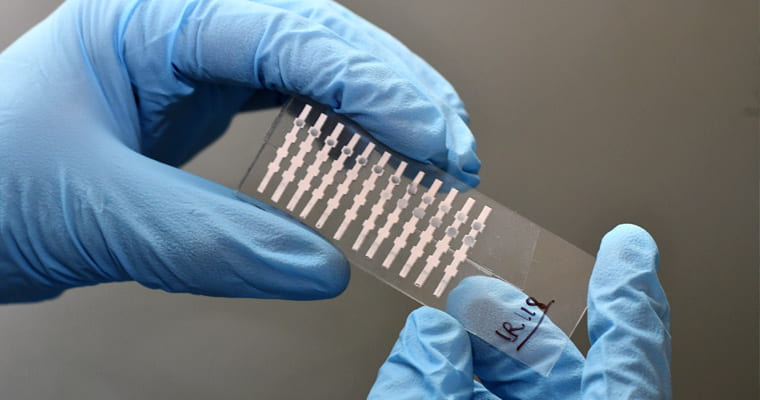
Photo credit: Colleen Locke
We are using nanoparticles to develop rapid diagnostics for applications in infectious diseases, food safety, and health. Our goal is to make a widely deployable device capable of with rapid sample-to-answer times, no special reagents to run, and can be easily operated by and end-user. In some cases we develop system with no power requirements or instrumentation. Our interests include developing paper-based assays for viruses such as dengue, Zika, Ebola, and Yellow Fever. The assays we develop typically rely on sandwich immunoassay formation, where the biomarker of interest binds to an immobilized antibody on a nitrocellulose strip and also an antibody conjugated to a nanoparticle, typically made of gold. The presence of gold at the test line provides the signal.
Our work focuses on the development of nanoparticle and nanoparticle-antibody conjugates:
• Engineering nanoparticle properties to enable readout by eye, fluorescence, or Surface Enhanced Raman Spectroscopy (SERS).
• Exploiting the unique material properties of gold nanoparticles to enable multiplexing by multicolor readout
• Manipulating nanoparticle surface properties and bioconjugation to optimize antibody-antigen recognition
Our work has included collaborations with the lab of Jose Gomez-Marquez and the Little Devices Lab at MIT, the lab of Paolo Bergese at the Università degli Studi di Brescia in Italy, and Victor Puntes at the Catalan Institute of Nanoscience and Nanotechnology (ICN2) in Spain.
Our goal is to make a widely deployable handheld device capable of rapidly diagnosing infectious diseases that requires no power or special reagents to run, and can be easily operated by and end-user.
Publications
D. R. Hristov, A. J. Pimentel, G. Ujialele, K. Hamad-Schifferli, “The immunoprobe aggregation state is central to dipstick immunoassay performance,” ACS Applied Materials and Interfaces, 2020, 12 (31), 34620-34629.
Link
C. Rodriguez-Quijada, J. Gomez-Marquez, K. Hamad-Schifferli, “Repurposing Old Antibodies for New Diseases by Exploiting Cross-Reactivity and Multicolored Nanoparticles,” ACS Nano, 2020, 14 (6), 6626–6635.
Link
D. R. Hristov, C. Rodriguez-Quijada, J. Gomez-Marquez, K. Hamad-Schifferli, “Designing Paper-Based Immunoassays for Biomedical Applications,” 2019, Sensors, Review Article for special issue on “Biosensors,” 2019, 19 (3), 554, invited submission.
Link
L. Russo, M. Sánchez-Purrà, C. Rodriguez-Quijada, B. M. Leonardo, V. Puntes*, and K. Hamad-Schifferli*, “Detection of resistance protein A (MxA) in paper-based immunoassays with surface enhanced Raman spectroscopy with AuAg nanoshells,” Nanoscale, 2019, 11, 10819-10827.
Link
M. Sánchez-Purrà, B. Roig-Solvas, C. Rodriguez-Quijada, B.M. Leonardo, and K. Hamad-Schifferli, “Reporter selection for Nanotags in Multiplexed Surface Enhanced Raman Spectroscopy Assays,” 2018, ACS Omega, 3 (9) 10733–10742.
Link
E. Phillips, A. K. Young, N. Albarran, J. Butler, K. Lujan, K. Hamad-Schifferli, J. Gomez-Marquez, “Ampli: A Construction Set for Paperfluidic Systems,” Advanced Healthcare Materials, 2018,1800104.
Link
I. Bosch,* H. de Puig,* M. Hiley, M. Carré-Camps, F. Perdomo-Celis, C. F. Narváez, D. M. Salgado, D. Senthoor, M. O’Grady, E. Phillips, A. Durbin, D. Fandos, H. Miyazaki, C.-W. Yen, M. Gélvez-Ramírez, R. V. Warke, L. S. Ribeiro, M. M. Teixeira, R. P. Almeida, J. E. Muñóz-Medina, J. Ludert, M. L. Nogueira, T. E. Colombo, A. C. B. Terzian, P. T. Bozza, A. S. Calheiros, Y. R. Vieira, G. Barbosa-Lima, A. Vizzoni, J. Cerbino-Neto, F. A. Bozza, T. M. L. Souza, M. R. O. Trugilho, A. M. B. de Filippis, P. C. de Sequeira, E. T. A. Marques, T. Magalhaes, F. J. Díaz, B. N. Restrepo, K. Marín, S. Mattar, D. Olson, E. J. Asturias, M. Lucera, M. Singla, G. R. Medigeshi, N. de Bosch, J. Tam, J. Gómez-Márquez, C. Clavet, L. Villar, K. Hamad-Schifferli,† L. Gehrke† “Rapid antigen tests for dengue virus serotypes and Zika virus in patient serum,” 2017, Science Translational Medicine, 9, eaan1589.
Link
H. de Puig, I. Bosch, L Gehrke, K. Hamad-Schifferli, “Challenges of the nano-bio interface lateral flow and dipstick immunoassays,” Trends in Biotechnology, 2017, 35 (12), 1169-1180.
Link
M. Sánchez-Purrà, B. Roig-Solvas, A.Versiani, C. Rodriguez-Quijada, H. de Puig, I. Bosch, L. Gehrke, K. Hamad-Schifferli, 2017, Molecular Systems Design & Engineering, 2, 401-409.
Link
M. Sánchez-Purrà, M. Carré-Camps, H. de Puig, I. Bosch, L. Gehrke, K. Hamad-Schifferli, “SERS-based sandwich immunoassays for multiplexed detection of Zika and dengue viral biomarkers,” 2017, ACS Infectious Diseases, 3 (10), 767-776.
Link
H. de Puig, I. Bosch, M. Carre-Camps, K. Hamad-Schifferli, “Effect of the protein corona on antibody-antigen binding in nanoparticle sandwich immunoassays,” 2017, Bioconjugate Chemistry, 28 (1), 230-238.
Link.
J. O. Tam, H. de Puig, C. Yen, I. Bosch, J. Gomez-Marquez, C. Clavet, K. Hamad-Schifferli,* L. Gehrke,* “A Comparison of Nanoparticle-Antibody Conjugation Strategies in Sandwich Immunoassays,” Journal of Immunoassay and Immunochemistry, 2016, in press.
Link
C. Yen, H. de Puig, J. O. Tam, J. Gomez-Marquez, I. Bosch, K. Hamad-Schifferli,* and L. Gehrke*, “Multicolored Silver Nanoparticles for Multiplexed Disease Diagnostics: Distinguishing Dengue, Yellow Fever, and Ebola Viruses,” 2015, Lab on a Chip, 15, 1638-1641.
Link